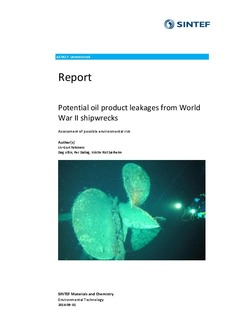| dc.contributor.author | Faksness, Liv Guri | |
| dc.contributor.author | Altin, Dag | |
| dc.contributor.author | Daling, Per Snorre | |
| dc.contributor.author | Sørheim, Kristin Rist | |
| dc.date.accessioned | 2017-07-19T15:35:06Z | |
| dc.date.available | 2017-07-19T15:35:06Z | |
| dc.date.created | 2017-07-19T14:12:11Z | |
| dc.date.issued | 2016-09-01 | |
| dc.identifier.isbn | 978-82-14-06064-5 | |
| dc.identifier.uri | http://hdl.handle.net/11250/2449062 | |
| dc.description.abstract | The water accommodated fractions (WAFs) of oils from the British sloop HMS "Bittern", the British carrier tanker RFA "Boardale", the German destroyer "Erich Giese", and the German cargo ship MS "Nordvard" have been studied with special emphasis on chemistry and taxicity. A limited study of the weathering properties of three of these oils (not "Nordvard") was also performed to predict the behaviour of oil at sea in order to optimize the effectiveness of potential response operations.
The results from taxicity studies show that the more "synthetic" oils from German WWII shipwrecks "Erich Giese" and "Nordvard" seem to have higher taxicity to marine organisms than the "mineral" oils from the British shipwrecks "Bittern" and Boardale".
There will be no risk for fire hazard during a response operation (flash points >60°C for all oils). Solidification on the sea surface is not expected for any of the oils. Ause of weir skimmer could be an option for oil spill recovery for "Erich Giese" and "Boardale", but reduced efficiency is expected for "Bittern" under certain winter conditions. Boom leakage is expected for "Erich Giese" due to low emulsion viscosities. There is a potential for use of dispersants for all three oils in a spill operation.
This has become the basic methodology for assessment on of the potential environmental risk of oil leakage from shipwrecks, and has given valuable input to the decision maker's recommendations of how to deal with the shipwrecks. It has resulted in an altering of the priority list for future oil recovery from WWII wrecks due to the potential for higher impact on the marine environment of coal based oils | nb_NO |
| dc.description.sponsorship | The Norwegian Coastal Administration | nb_NO |
| dc.language.iso | eng | nb_NO |
| dc.publisher | SINTEF | nb_NO |
| dc.relation.ispartofseries | SINTEF report;A27827 | |
| dc.rights | Attribution-NonCommercial-NoDerivatives 4.0 Internasjonal | * |
| dc.rights.uri | http://creativecommons.org/licenses/by-nc-nd/4.0/deed.no | * |
| dc.subject | WW2 shipwreck | nb_NO |
| dc.subject | Bunker oil | nb_NO |
| dc.subject | Chemistry | nb_NO |
| dc.subject | Toxicity | nb_NO |
| dc.subject | WAF | nb_NO |
| dc.subject | Weathering | nb_NO |
| dc.title | Potential oil product leakages from World War II shipwrecks - Assessment of possible environmental risk | nb_NO |
| dc.type | Research report | nb_NO |
| dc.description.version | publishedVersion | nb_NO |
| dc.rights.holder | SINTEF Ocean | nb_NO |
| dc.source.pagenumber | 143 | nb_NO |
| dc.identifier.cristin | 1482610 | |
| cristin.unitcode | 7566,6,0,0 | |
| cristin.unitname | Miljøteknologi | |
| cristin.ispublished | true | |
| cristin.fulltext | original | |

